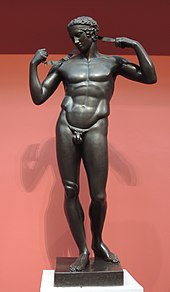
Back Дыядумен (статуя) BE Diadumen Catalan Diadumenos German Διαδούμενος Greek Diadúmeno Spanish Diadumenos Finnish Diadumène French Diadumeno GL קושר הסרט HE Diadumeno Italian


The Diadumenos ("diadem-bearer"), together with the Doryphoros (spear bearer), are two of the most famous figural types of the sculptor Polyclitus, forming a basic pattern of Ancient Greek sculpture that all present strictly idealized representations of young male athletes in a convincingly naturalistic manner.
The Diadumenos is the winner of an athletic contest at a games, still nude after the contest and lifting his arms to knot the diadem, a ribbon-band that identifies the winner and which in the bronze original of about 420 BCE would have been represented by a ribbon of bronze.[1] The figure stands in contrapposto with his weight on his right foot, his left knee slightly bent and his head inclined slightly to the right, self-contained, seeming to be lost in thought. Phidias was credited with a statue of a victor at Olympia in the act of tying the fillet around his head; besides Polyclitus, his successors Lysippos and Scopas also created figures of this kind.
- ^ In Hellenistic times the diadem became a symbol of royalty; in the Polyclitan Diadumenos, however, the action is still a simple tying-on of the winner's headband.